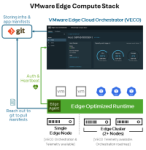The global edge AI market was estimated at $20 billion in 2023. By 2032, Fortune Business Insights predicts that value will reach $269.82 billion—a CAGR of 33%. At VMware Explore Las Vegas Sanjay Uppal, VP and GM of the Software-Defined Edge division of Broadcom, presented an insightful session on the transformative potential of edge AI and the software-defined edge. Edge AI is revolutionizing industries from retail to manufacturing. Organizations need not only AI tools, but the infrastructure that will prepare them to optimize those tools to gain real business results.
With real-time data processing at the edge AI workloads can operate autonomously, creating opportunities for faster insights, improved customer experiences, and operational efficiency. VMware software-defined edge (SDE) is a comprehensive solution that enables AI at the edge and brings together VMware Edge Compute Stack, VMware VeloCloud SD-WAN, VMware VeloCloud SASE, secured by Symantec, and VMware Telco Cloud Platform.
Sanjay Uppal made a compelling case for businesses to embrace this new era of edge AI by asking, “Are you ready for this transformation?” The time is now for organizations to gear up for AI-driven growth across all industries. Catch his full presentation below, including insights into edge infrastructure and AI evolution from featured guest speakers Bill Chang, Ed Fox, John Pieratt, and Lu Zhang.
What is edge AI?
At its core, edge AI refers to any artificial intelligence workload processed outside of traditional data centers, both public and private. To make edge AI possible, you need AI in two places: at the edge, and delivered to the edge. To optimize these workloads, infrastructure needs to be AI-ready and AI-aware.
When we look at AI today, it’s clear that it’s spreading across multiple industries—manufacturing, healthcare, retail, food and agriculture—and VMware customers are deploying AI applications in these verticals. AI is everywhere.
For example, some of the largest manufacturers report that 93% believe AI will be crucial for growth and innovation. In retail, 80% of executives expect to be using AI automation by 2025. AI is driving everything from virtualizing factory floor computing, shrinkage reduction through computer vision, self-service checkout systems, and just-in-time inventory ordering. This kind of real-time data processing reduces costs, improves operational efficiency, and delivers value directly to the business.
VMware software-defined edge gets your business ready for edge AI
The VMware software-defined edge stack is built to solve edge AI with a simple structure. Think of it as your favorite sandwich cookie.
- The top layer is VMware Edge Compute Stack, where AI workloads run directly at the edge. It supports the infrastructure needed to run real-time applications like video analytics and robotics without relying on centralized data centers.
- The bottom layer is the network foundation, enabled by VMware Telco Cloud Platform. It supports edge AI workloads by enabling the network to recognize and respond to the unique demands of AI-driven applications.
- The middle layer — the tasty filling that makes the cookie complete — is the intelligent overlay, the VMware VeloCloud family. VeloCloud is no longer only a tool for branch office connectivity. It now plays a critical role in recognizing and optimizing the performance of Edge AI applications. By probing the underlying network, the intelligent overlay can make decisions about quality of service and help ensure that the network adapts in real time to the needs of AI workloads.
These layers simplify the setup, operation, and maintenance of workloads—anything from a network function running a radio access network (RAN) to a robot on the factory floor or an AI model deployed in a retail store.
Examples of emerging workloads
One area of growing excitement is fixed wireless access (FWA). Alongside satellite networks, FWA is one of the fastest-growing underlays supporting edge AI. The combination of fiber, satellite, and wireless technologies creates a more balanced and symmetric network, supporting the new types of workloads that edge AI demands. New VMware VeloCloud SD-WAN Edge devices, announced at VMware Explore 2024 Las Vegas, will support emerging underlays and help organizations pave the way to edge AI.
A key question is: What makes edge AI workloads different? They exist both at the data center and all the way out at the edge. Thanks to the global footprint of VeloCloud, VMware collects almost five trillion data points annually, giving us unparalleled insight into where applications are running, who is running them, and what kind of traffic they generate. This will help ensure that the network delivers the best performance for these workloads.
One example of these new workloads is chatbots. Unlike traditional asymmetric traffic, chatbots generate a lot more traffic from the endpoints than we expected—and this is just the beginning. With the advent of Retrieval Augmented Generation (RAG), AI models are now constantly being updated with new data from across a business. This creates a flood of new data being produced at all points of the network, which needs to be filtered, aggregated, and pushed to the Small Language Models (SLMs) or Large Language Models (LLMs) that are located either on-site or in data centers.
Adapting the network to handle edge AI workloads
With smaller models becoming more common, there’s less tolerance for packet loss, making resilient networks more critical than ever. These AI workloads are often asymmetric, bursty, and involve a lot of peer-to-peer communication. This means traditional networking approaches aren’t sufficient.
To address this, VMware is enhancing its award-winning Dynamic Multipath Optimization™ (DMPO). By leveraging AI, DMPO is becoming smarter, able to react faster to workload needs, prioritize traffic based on business policies, and adjust in real-time to the performance of the underlying network. This helps us make sense of the five trillion parameters we process, so we can recognize AI and non-AI applications and optimize how they run on the network. These optimizations ensure that the network will handle even the most demanding edge AI workloads.
Another exciting development is the integration between Symantec PoPs and VeloCloud PoPs. This brings together a unified SASE solution that enhances security for edge AI workloads. With SASE, VMware is combining zero-trust principles, SD-WAN, and secure edge applications to ensure that edge AI workloads are not only fast and efficient but also secure and resilient.
A new era for AI
As edge AI continues to grow, the need for a responsive and adaptive network infrastructure becomes more critical. VMware’s software-defined edge portfolio helps your business meet the demands of this new era. Whether you’re running robotics on a factory floor, managing AI-powered customer service in retail, or delivering cutting-edge telco services, VMware’s edge solutions are designed to optimize connectivity, security, and performance at every level.
The future of AI is distributed, and edge AI is at the heart of this transformation. Whether you’re starting your AI journey or looking to scale, VMware’s edge AI solutions are ready to help you take the leap into this exciting new world.







